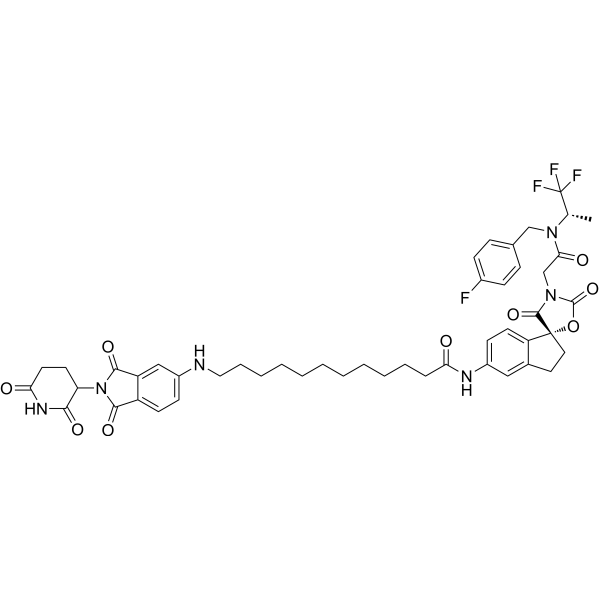| Cas No.: | 2417097-18-6 |
| Chemical Name: | JQAD1 |
| Synonyms: | JQAD1 |
| SMILES: | O=C1N(C(=O)O[C@]21CCC1=CC(NC(=O)CCCCCCCCCCCNC3=CC=C4C(=O)N(C5CCC(=O)NC5=O)C(=O)C4=C3)=CC=C21)CC(=O)N([C@@H](C)C(F)(F)F)CC1C=CC(F)=CC=1 |
| Formula: | C48H52F4N6O9 |
| M.Wt: | 932.954906463623 |
| Purity: | >98% |
| Sotrage: | 2 years -20°C Powder, 2 weeks 4°C in DMSO, 6 months -80°C in DMSO |
| Description: | JQAD1 is a CRBN-dependent PROTAC that selectively targets EP300 for degradation. JQAD1 suppresses EP300 expression and the H3K27ac modification. JQAD1 induces apoptosis. JQAD1 can be used in research of cancer. |
| In Vivo: | JQAD1 (40 mg/kg; i.p.; once daily, for 21 days) inhibits tumor growth in NSG mice with Kelly NB cell xenografts [1]. It also prolongs survival in these mice. In another study using CD1 mice, JQAD1 was administered at a dosage of 10 mg/kg via intraperitoneal injection for pharmacokinetic analysis [1]. The results showed that JQAD1 had a half-life of 13.3 hours (±3.37 SD) in murine serum and reached a maximum concentration (Cmax) of 7 μmol/L. |
| In Vitro: | JQAD1 inhibits the expression of EP300, suppresses H3K27ac modification, and induces apoptosis in Kelly NB cells (control group) rather than CRBN knockout cells [1]. Treatment with JQAD1 (0.5 or 1 μM; 6-96 hours) leads to early time-dependent induction of the sub G1 peak, indicating apoptosis in Kelly and NGP cells [1]. JQAD1 (1 μM; 12-36 hours) induces apoptosis in Kelly NB cells [1]. Cells treated with JQAD1 (0.5 μM; 24 hours) show upregulation of pro-apoptotic BH3 effectors BIM, BID, and PUMA, as well as pro-apoptotic mediators BAX, along with the upregulation of their inhibitors BCL2 and MCL1 [1]. JQAD1 (0.5 and 1 μM; 24 hours) disrupts MYCN expression [1]. JQAD1 (0.5 μM; 24 hours) results in loss of H3K27ac on chromatin [1]. JQAD1 (1.2 nM - 20 μM; 5 days) exhibits broad CRBN-dependent anti-tumor activity across cancer cell lines [1]. JQAD1 induces time-dependent degradation of EP300, observed as early as 16 hours [1]. Western Blot Analysis [1]: Cell Line: MYCN-amplified neuroblastoma (NB) cells Concentration: 0.1, 0.5, 1, 3, 5, and 10 µM Incubation Time: 24 hours Result: Demonstrated a dose-dependent decrease in EP300 expression, accompanied by a parallel loss of the H3K27ac modification. Induced selective loss of EP300 expression coincided with cleavage of PARP1, indicating the initiation of apoptosis. Western Blot Analysis [1]: Cell Line: Kelly NB cells Concentration: 1 µM Incubation Time: 12, 24, and 36 hours Result: Increased expression of cleaved caspase-3 and cleaved PARP1 in a dose-dependent manner. |
| References: | [1]. Durbin AD, et, al. EP300 Selectively Controls the Enhancer Landscape of MYCN-Amplified Neuroblastoma. Cancer Discov. 2022 Mar 1;12(3):730-751. |

 To enhance service speed and avoid tariff delays, we've opened a US warehouse. All US orders ship directly from our US facility.
To enhance service speed and avoid tariff delays, we've opened a US warehouse. All US orders ship directly from our US facility.




















